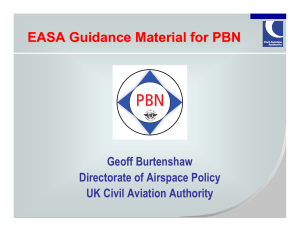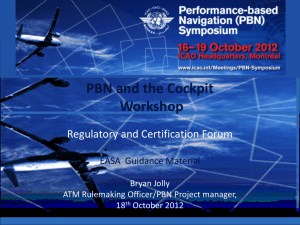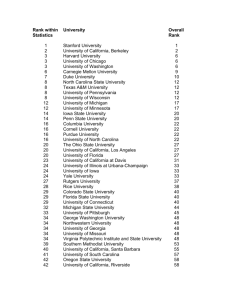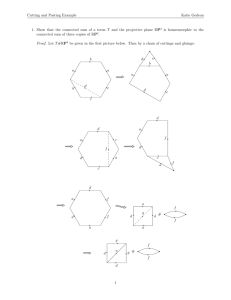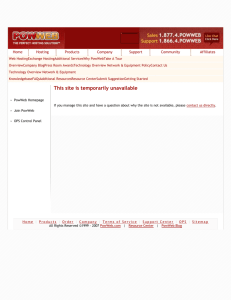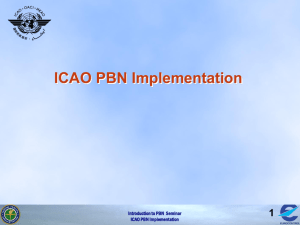PBN Operational Approval Workshop
advertisement
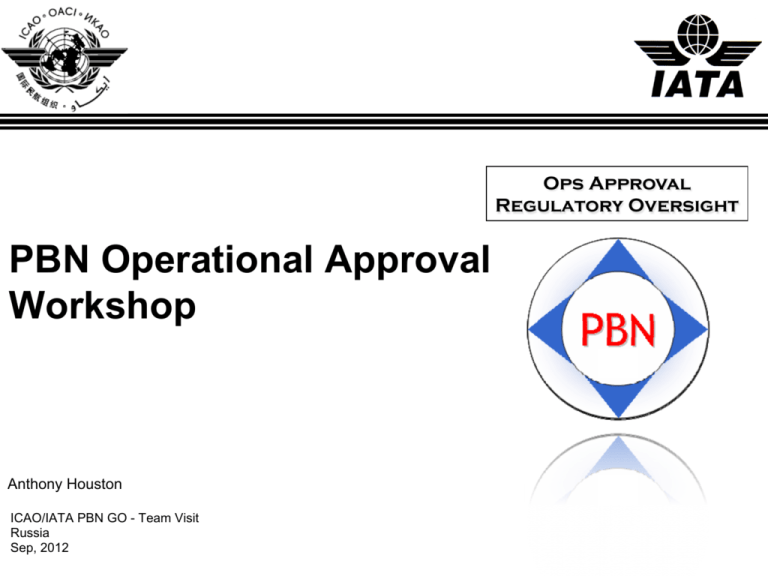
Ops Approval Regulatory Oversight PBN Operational Approval Workshop Anthony Houston ICAO/IATA PBN GO - Team Visit Russia Sep, 2012 Objectives • Snapshot of the current status and future requirements in Russia • Discuss best practices for Ops Approval • Understanding of operational and airworthiness requirements • Established processes for approval • Discuss oversight requirements • Review best practices • Identify steps to “Move Forward” Performance Based Navigation depends on: • A defined airspace concept • An available navigation aid infrastructure • Functional requirements of the Navigation Specification prescribed for PBN operations • Approved RNAV/RNP equipment installed that meets performance requirements • Air crew satisfying the operating requirements set out by State regulations Global PBN Task Force Go-Team TAKEOFF RNAV 2 RNP 4 ENROUTE OCEANIC RNP APCH APPROACH Slide 3 LANDING PBN Operational Approval Why we need operational approvals? • Determine that the proposed operation meets the minimum requirements; AND • Assess the operator’s capability to meet the operational intent of the particular navigation specification Note: For the purpose of this discussion, the term Operational Approval refers to Airworthiness and Operational Approval. Slide 4 Lessons Learned • Many Operators struggle to understand the requirements – Equipment eligibility issues / training requirements / data management – Can cause reluctance to apply for approval • Common regulator responses to PBN approvals – Lack of oversight – ”Rubber Stamp” – Unreasonable oversight – Require more than the minimum req’d – Impeding oversight – Refuse approval due to lack of confidence Bottom Line: Operational approval >>>>>>> aircraft movements Without it NOTHING HAPPENS! Slide 5 Part 1 Agenda • Group discussion on current situation in Russia • Ops Approval Guidance Materials • CAA/Regulator Requirements • Operator Requirements • Identify gaps that are hindering approvals Part 2 Agenda • • • • Regulatory Oversight Process Other issues Ops Approval Exercise Questions and Recommendations to move forward Current PBN Situation Group discussion • General understanding of PBN at the working level (Regulator, ANSP and aircraft operators)? • Russia’s PBN existing regulatory framework and approvals process • Current Nav applications in play • Current challenges/impediments to implementation • Future PBN applications to be implemented • Near-term / Long-term • Regulator and Operator future requirements Ops Approval Workshop Questionnaire PBN Authorizations in Russia Navigation Specification ICAO Standards Other International Standards Implementation of GPS receivers Regulatory Framework Nav Specs in play Standards Rules and Procedures RNAV 10 RNAV 5 RNAV 2 RNAV 1 RNP 4 RNP 2 Advanced RNP Basic RNP 1 RNP 0.3 RNP APCH Instruction 25.01.2002 № НА-36-р (non-precision approach with area nav) RNP AR APCH P-­‐RNAV Instruction 4.02.2003 № НА-21-р B-­‐RNAV Letter 10.10.98 NO 3.10-41 Order 4.03.1998 No 61 DGCA Advisory Material Qualification Requirements? • KT 34-01 «Airborne equipment of satellite navigation», 4th revision; • KT-253 «Airborne equipment of GNSS/GBAS»; • KT-229 «Airborne equipment of GNSS/SBAS». Slide 11 Ops Approval Guidance Materials • ICAO DOC 9613 - PBN Manual, Vol. 1, Attch C • ICAO DOC 8335 – w/ regard to acceptance of foreign approvals • ICAO Ops Approval Manual (Draft) • Certification Documentation • EASA AMCs / FAA ACs • ICAO SAM ACs (1st attempt to harmonize) • Ops Approval Process / Requirements ICAO DOC 9613 – Attachment C Operational Approval • • This attachment provides high level guidance on the processes the regulatory bodies should follow when applying the navigation specifications in the approval process. Further detailed guidance can be found in the PBN Operational Approval manual. ICAO DOC 9613 – Attachment C Operational Approval • Section 1 – Overview • A PBN operational approval authorises an operator to carry out defined PBN operations with specific aircraft in designated airspace. • The operational approval for an operator may be issued when the operator has demonstrated compliance with the relevant airworthiness, continued airworthiness, and flight operations requirements to the State of Registry / Operator regulatory authority. ICAO DOC 9613 – Attachment C Operational Approval • Section 2 – State Regulatory Responsibilities • Individual States must develop national regulatory material which addresses the PBN applications relevant to their airspace or relevant to operations conducted in another State by the operators and aircraft registered in that State. In line with current practice, small or less capable States may elect to adopt or even adapt the national regulatory material of the major certification States as an acceptable means of compliance. ICAO DOC 9613 – Attachment C Operational Approval • Section 3 – Operational Approval The operational approval assessment must take account of the following: a) Aircraft eligibility and airworthiness compliance; b) Operating procedures for the navigation systems used; c) Control of operating procedures; d) Flight crew initial training and continuing competency requirements; e) Dispatch training requirements; f) Control of navigation database procedures; g) Continued Airworthiness. ICAO DOC 9613 – Attachment C Operational Approval • • • • Section 1 - Overview Section 2 – State Regulatory Responsibilities Section 3 – Operational Approval Assessment Section 4 – Documentation of Operational Approval • Section 5 – State Regulatory Material • Section 6 – Approval Process • Section 7 – Foreign Operations . PBN Operational Approval Manual (Draft) Doc 99xx AN/yyy PBN Operational Approval Manual/Circular/Leaflet Notice to Users This document is an unedited advance version of an ICAO publication as approved, in principle, by the Secretary General, which is rendered available to the public for convenience. The final edited version may still undergo alterations in the process of editing. Consequently, ICAO accepts no responsibility or liability of any kind should the final text of this publication be at variance from that appearing here. Advance edition (unedited) PBN Ops Approval Manual DRAFT • Status: Advanced unedited edition in circulation. • Scope: Operational approval against a PBN navigation specification – Intended to supplement existing guidance in the Manual of Procedures for Operations Inspection, Certification and Continued Surveillance, DOC 8335 • Table of Contents: – CH 1. PBN (high-level description) – CH 2. Certification and Operational Approval – CH 3. Operational Approval Guidelines – CH 4. Navigation Specifications: – Job Aid for each – Annexes: RNAV systems; Example regulatory text; and Example application form Slide 19 PBN Ops Approval Manual DRAFT Ops Approval Guidance on Certification Standards • Recommended to be referenced in the legislation as the certifying document • Covers the following nav specs: – – – – RNAV-5, -10, -2, and -1 Basic RNP RNP APCH [LNAV], RNP APCH [LNAV/(Baro)VNAV] RNP APCH AR • Each Nav Spec has 2 AC: general requirements and Job-Aid (=checklist) CAA/Regulator Requirements Establish regulatory framework / guidance material • PBN operational approval (requirements for an approval) • Privileges of an operator holding a specific approval • Continued validity of a specific approval • Changes to operations: subject to a specific approval • PBN operations - define implemented nav specs and the related certifying documentation (AC or AMC) CAA/Regulator Requirements PBN Regulations should at least include: • Basic PBN Concept Definitions • General requirements for authorization / approval • Requirements for electronic navigation data management • General training requirements Example Regulatory Text is in the PBN Operational Approval Manual Global PBN Task(ANNEX Force Go-Team C) (Draft) Slide 22 CAA/Regulator Requirements National Regulatory material / certifying documentation • The AC, AMC or Order is the certifying document; compliance cannot be approved against the PBN Manual nor any Navigation Specification • States may develop national regulatory material using the PBN NS and/or relevant ACs / Orders or AMC / TGLs as guidance material Navigation Specification RNP 10 (RNAV 10) Relevant Airworthiness/Approval Document FAA Order 8400.12A RNP 4 FAA Order 8400.33 RNAV 1 and 2 AC 90-100A or AMC 20-16 RNP AR APCH AC 90-101 or AMC 20-26 23 Slide 23 Ops Approval Guidance on Certification Standards (EASA / FAA) Ops Approval Guidance on Certification Standards (ICAO SAM) Flight Phase Ops Approval Guidance on Certification Standards En-route Oceanic/Remote Continental STAR Approach Initial Intermediate Final SID Applicable Complementary Documents guidance material AC 91-001 EASA AMC 20-12 Missed RNAV 10 FAA 8400.12 AC 91-002 EASA AMC 20-4 RNAV 5 FAA 90-96() RNP 4 AC 91-004 FAA 8400.33 RNP 2 tbd tba AC 91-003 EASA TGL 10 RNAV 2 FAA AC 90-100() AC 91-006 EASA TGL 10 B-RNP 1 FAA AC 90-105 AC91-003 EASA TGL 10 RNAV 1 FAA AC 90-100() A-RNP tbd RNP APCH AC 91-008 (LNAV) RNP APCH tba EASA AMC 20-27 AC 91-010 FAA AC 90-105 tbd EASA AMC 20-28 (LNAV/VNAV) RNP APCH (LP/LPV) FAA AC 90-107 AC 91-009 EASA AMC 20-26 RNP AR FAA AC 90-101 RF Electronic Data Management tbd FAA AC 90-105 tbd EASA IR 21 subpart G FAA AC 20-153 CAA/Regulator Requirements Establish the Approval Process for Air Operators/ ANSP’s • Should be a 5 Step Process: – 1) Phase one: Pre-application – 2) Phase two: Formal application – 3) Phase three: Analysis of the documentation – 4) Phase four: Demonstration and inspection – 5) Phase five: DGCA Approval • Process can be simplified in certain cases (e.g. RNAV 5) 5 Step Approval Process • Step 1 – Pre-Application Phase: The operator initiates the approval process by reviewing the requirements, establishing that the aircraft, the operating procedures, the maintenance procedures and the training meet the requirements; and developing a written proposal to the regulator. A meeting with the CAA and using the Job-Aids is recommended. • Step 2 – Formal Application Phase: The operator submits the formal, written application for approval to the CAA, which appoints a project manager. Example form in App C. Slide 28 5 Step Approval Process • Step 3 – Document Evaluation Phase: The CAA project manager evaluates the formal, written application for approval to determine if all the requirements are being met. • Step 4 – Demonstration and Inspection Phase: During a formal inspection by the project manager (assisted as necessary by a CAA team), the operator demonstrates how the requirements are being met. • Step 5 – Approval Phase: issue of the approval (approval of Ops manual amendment + Ops specs or Letter of acceptance) Slide 29 CAA/Regulator Requirements Issue Approvals • An amendment to the Operations Manual if applicable, and • A Letter of Authorization (LOA) or • An Operations Specification of the AOC (Ops Spec) Foreign Operations: • Not necessary to issue foreign Ops Specs • Approval of the State of the Operator should be accepted for foreign operator PBN operations in Russia (State of Registry for GA) Issuance of Approval Examples of PBN Operations Specifications Y N x Navigation Specifications for PBN Operations RNAV 10 RNAV 5 RNAV 2 RNAV 1 RNP 4 Basic RNP 1 RNP APCH […] RNP AR APCH Also valid for airspace /routes designated as RNP 10 Also valid for B-RNAV routes Also valid for routes/procedures P-RNAV Valid for approach procedures designated as RNAV (GNSS) Valid for approach procedures designated as RNAV (RNP) and RNP SAAAR Apch • RNP APCH should be precisely defined by LNAV, LP, LNAV/ VNAV, LPV as appropriate in the […] CAA Inspector Requirements Responsibility: Must ensure the PBN operation is safe • Training and qualification of inspectors for PBN approval: – Must be appropriately experienced and trained – Must be trained and competent in all ops elements: • Aircraft capability, functionality • Operating procedures, dispatch, planning • Crew procedures • Flight, dispatch and controller training – Must have an understanding of: • Procedure design and implementation • ATC procedures Operator Requirements • Submit Application for authorization (Ops Spec/ Letter of Approval) • Determine aircraft/equipment eligibility • Establish operating procedures • Control operating procedures through review/entry in Ops Manual • Incorporate flight crew training requirements • Control of the navigation data-base process Slide 33 Operator Requirements Common Air Carrier Concerns • Harmonization & Access • Aircraft Equipage Eligibility • Pilot/Dispatcher Training • Operator’s Documentation • Nav Database Validation & Maint • Issues regarding RAIM and RAIM monitoring • Maintenance & Continual Operational Monitoring • Regulator position on ‘Acceptable Means of Compliance’ 34 Aircraft Eligibility Scenarios Scenario Aircraft Certification Status Actions by Operator/Owner 1 Aircraft designed and type certificated for PBN application. Documented in AFM, TC or the STC. No action required, aircraft eligible for PBN application. 2 Aircraft equipped for PBN application but not Obtain SB (and associated amendment pages to the certified. No statement in AFM. SB AFM) from the aircraft manufacturer. available from the aircraft manufacturer. 3 Aircraft equipped for PBN application. No Establish if the statement of compliance is statement in AFM. SB not available. acceptable to the regulatory authority of the State of Statement of compliance available from the Registry of the aircraft. aircraft manufacturer. 4 Aircraft equipped for PBN application. No statement in AFM. SB not available. Statement of compliance from the aircraft manufacturer not available. Develop detailed submission to State of Registry showing how the existing aircraft equipment meets the PBN application requirements. Aircraft not equipped for PBN application Modify aircraft in accordance with the aircraft manufacturer SB or develop a major modification in conjunction with an approved design organization in order to obtain an approval from the Slide 35 State of Registry (STC). 5 Ques%ons ? Part 2 Agenda • Other issues • Flight Validation / Nav Database Validation • Regulatory Oversight Process • Ops Approval Exercise • Questions and Recommendations to move forward Regulatory Oversight Key Concepts to Ensure Adequate Oversight • Line observation is essential – real world issues drive real solutions • Continuing education – keep up with changes in technology and international regulation • Robust reporting allows data analysis and trending • Safety over-rides efficiency Regulatory Oversight Regulatory Oversight Process (After Carrier’s Implementation of PBN operations) • Regulator’s key goals through oversight: 1. Ensure safety of domestic PBN operations 2. Ensure safety of foreign operators PBN ops in domestic airspace 3. Ensure compliance with regulation/advisory materials • Other regulatory responsibilities: 1. Review and approve AMOC’s (alternate means of compliance) 2. Review and approve additional PBN carrier approvals and airport specific approaches/departures 3. Withdraw approvals as required by violation/incident history Regulatory Oversight Regulatory Oversight Process – Regulator’s Tools • Compliance tools: 1. 2. 3. 4. 5. • Anonymous reporting programs (ASAP) Simulator spot checks Line checks to PBN specific airports Data review (data provided by carrier via DFDR analysis) Spot checks on maintenance of nav accuracy and nav database loading procedures Continuing surveillance tools: 1. Approved SMS programme should specifically break-out PBN incidents 2. Coordination with other regulators and ICAO to stay current on revisions to international guidance materials 3. Understand foreign operator’s regulatory requirements to ensure interoperability with Russia’s regulatory guidance 4. Keeping inspectors educated on changes and new technology Regulatory Oversight Regulatory Oversight Process – Data Capture & Analysis • Importance of Data Capture on carrier’s PBN operations: 1. Allows comparison to level of carrier reporting – can determine if carrier accurately reporting all issues 2. Permits “trend analysis” and surveillance on specific problem areas 3. Identifies aircraft nav maintenance or database anomalies 4. When combined with SMS data, improves overall analysis of carrier compliance 5. Can be used to cross-check line check and sim check reports to determine if inspectors accurately reporting airman performance Regulatory Oversight Regulatory Oversight Process – Aircraft Maintenance • Aircraft maintenance oversight challenges: 1. Ensure mechanics loading databases as soon as practical after database cycle release 2. MEL’s related to Nav accuracy and navigation avionics must be tracked and cleared in logbooks and maintenance system 3. Proper coordination and communication to dispatch and pilots of nav system MEL’s/downgrades 4. Proper data-loader maintenance (prevention of database corruption via data-loader) 5. Can be used to cross-check line check and sim check reports to determine if inspectors accurately reporting airman performance • Ops Approval Exercise (RNAV 1 / RNAV 2 / RNP APCH) Exercise: RNAV-1 & RNAV-2 RNP APCH • Two exercises to illustrate the approval process of PBN ops • Review with the attendance the Job-Aids page by page. • Illustrate the Job-Aid usage (either AC or Ops Approval Manual Job-Aids) for 2 PBN nav specs with: – Airline personnel provides operator’s input – Ops Inspectors provide the requested CAA inputs – Other participants provide comments/inputs • Complete exercise for RNAV-1 & 2 and RNP APCH Questions and Conclusions
